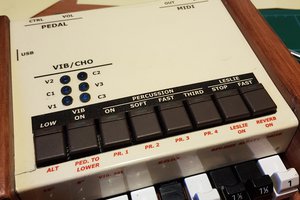Primary Features
- 2-voice digital synthesiser with true polyphony
- 5 oscillators with dedicated waveforms
- State-Varible-Filter with independent LP, HP, BP and Notch mix controls
- Amplitude and Filter ADSR envelopes
- Two modulation sources (LFO and keyboard velocity) with three destinations, each with independent bipolar depth controls
- Digital distortion FX
- Changeable scales on the keyboard
- ‘Vintage’ parameter for replicating old/broken analogue synth voices
- Full MIDI I/O integration
- Polyphonic Aftertouch expression (MIDI-out only)
- Charming miniature grand piano form
Development Specs
- The brain and sound engine of the synthesiser are seperate Linux applications running on a BeagleBone Black board (a requirement of the Element14 Design Challenge), which communicate via software sockets. The brain application is developed in C, and the sound engine application is developed in C++ using the Maximilian Audio DSP library and RtAudio. See the BeagleBone Black directory in the GitHub repo for the code for these applications.
- The keyboard and panel use Arduino Pro Mini boards for sensor/control scanning. The Arduinos communicate with the BeagleBone Black via serial. See the Arduino directory in the GitHub repo for the keyboard and panel code.
- The keyboard mechanism uses homemade pressure sensors made out of Velostat.
- There is a Mac OS X editor application for saving and loading patches on the synth, written in C++ using the JUCE framework. See the VtsEditor directory for the code.
- Completely open-source.
For more info on the software architecture see here.
Videos
Project Outline
I’ve got a certain fascination with vintage wooden toy pianos - there’s something so aesthetically-pleasing and charming about the miniature form factor and clunky keyboard mechanism. Because of this I’ve ended up taking part in a number of different toy piano projects, therefore the Vintage Toy Synthesiser came about as an evolution from a number of past endeavours.
The roots of the project started with an experimental toy piano sampling project with my brother Ali Lacey, which eventually became the Impact Soundworks Curio: Cinematic Toy Piano Kontakt instrument; followed by a project I did at MIDI HACK 2015 where I turned a toy piano into a basic USB-MIDI controller. I felt like the next logical step in this series of projects would be to attempt to convert the piano into a standalone synthesiser; an idea inspired by my day job at Modal Electronics. One great thing about this particular project is that it allowed me to combine what I do at my day job with my ‘out of hours’ activities/identity as a music tech maker/hacker.
My main aim of the project was to allow the existing key mechanism and enclosure of a vintage wooden toy piano to act as a fully functional standalone digital synth. I didn’t set out to create anything revolutionary or premium in regards to the synthesis engine or control interface; in fact I wanted these elements to remain ‘vintage’ and fairly simple akin to the existing instrument - a classic subtractive synthesis engine with standard oscillator waveforms, using just regular dials and switches for controlling the parameters. My main focus was making sure that the synth would retain the existing charming aesthetics and physical character of the toy piano, carefully designing any new elements of the object around this goal, so this was just as much an art & design project as it was a music technology and engineering project.
Old objects like this are sometimes discarded or thrown away because their functionality is now seen as being inferior to their modern day versions, however there is a special quality...
Read more » Liam Lacey
Liam Lacey









 Pierre-Loup M.
Pierre-Loup M.
 Revathi Kannan
Revathi Kannan
 Ember Leona
Ember Leona
 Stefano Garuti
Stefano Garuti
I like that it was made from a vintage toy mini piano. Over all very nice.